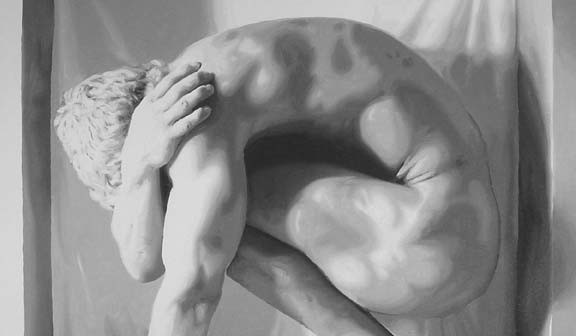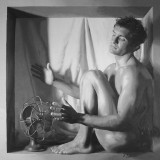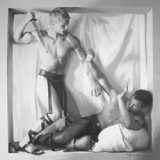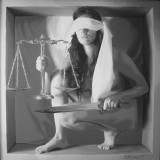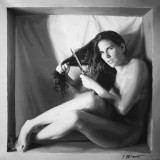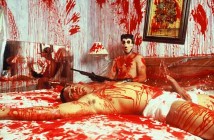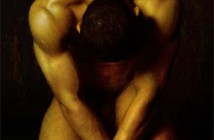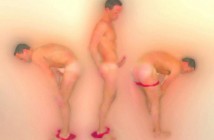The remarkable paintings of the artist E. Gibbons, allegorical nudes in black and white. The work of Gibbons has been featured on the Art of Love some time ago, I finally had the opportunity to speak with the artist about his work.
An interview with the artist E. Gibbons by Frontosa
Where did the ‘box’ come from? What does it mean?
The box is many things at once. It’s roots are in the french tradition of Trompe l’ oeil painting (Meaning to “fool the eye”) Where artists would paint things so realistic that they appeared to be real , thus fooling the eye of the viewer. My works, on a simple level are to look like sculptures that are imbedded into the exhibit wall. My Boxes come from several experiences in combination. Trips to the Louvre in Paris and seeing sculptures in niches (I like the hard lines of architecture contrasting with the soft flesh lines of the figure) Exposure to the masterworks by artists like Ingress, Michelangelo’s “slaves” that filled in triangular voids in his Sistine Chappel, The photography of Von Gloedon, Bruce Webber, Jeff Palmer, add a dash of Warhol, Duchamp, Hokusai and Matisse and you got me.
Your allegorical references are they based on historical examples? or do you compose new ones?
Some are for sure, like Caine and Able or Christ, or Mary Magedeline, or Mythological figures like Justice, Hera, Aquarious, Narcissus… BUT More often they are extensions of myself, my own feelings, experiences, fears, joys and hopes. Probably why most of the figures are male. I have some female images as we all have our feminine sides, but as the artist, my work probably tells more about myself even if it is sometimes not my intension.
Besides limiting yourself to the space of the box, you also paint solely in black and white, why?
Well, the box series is black and white, but I do paint in color from time to time. I have chosen this series to be in black and white to remove the figures from our world. I think if they were in flesh-tones, they would be hyper-real. They would move from being nudes in artwork; to naked people on the wall. I use a technique from the 1800’s where artists would paint in black and white and then glaze colors on top in thin layers. Sort of like coloring on-top of a black and white photo. It gives it a antique look. My paintings are technically very good “underpaintings.”
The ‘boxed’ females are new to me, previously you painted only males. Why did you decide to do so?
I started with what I knew would be easier to sell. a very pragmatic decision. Nude Males, classical ones, do very well in the art market because they are rare and the buyers TEND to have double income and no kids. (Plus they know a good thing when they see it.) I knew from the beginning that I wanted to do many types of people though. Men, women, younger people, older people, thin, fat etc… My larger goal is to have 100 pieces on a single wall in a museum. My dream would be for NYC’s MoMA. I am up to 80 pieces right now and have sold about 20% of them. I exhibit in Provincetown, New York, Philadelphia, New Hope, as well as London and Paris. I hope to get into some galleries on the West Coast.
Do you consider the nudity in your work erotic?
I suppose Eroticism is in the eye of the beholder. Some work is definitely more sensual than others, but I conscientiously never show the models genitals. I do not want my work to be overtly erotic but prefer the subtleties. If you were to see a penis, I think that is all some viewers will ever see and judge the series by some flap of skin. ALSO this series is headed to a book deal with Green Candy Press. To avoid the book being kept in some “adult” section of stores to collect dust, I made a decision early on to not paint genitalia. Maybe though, some day, a figure or two will show their “stuff” if the theme of Eros is appropriate to the piece. I would also be ok in doing a special commission if that is what a client wanted. (Though it might not be included in the book)
You published a book about Christian Voodoo, do you think your Catholic background is in some way present your work? ( personally I think your work extends, in a way, the historical iconography often used in religious images )
Sure, but I am not your typical Catholic. I have lived in Japan, Egypt, and visited many other places and have a DEEP respect for those faiths. Personally I feel there is more than one path to paradise. I am currently working out some other deity images in a box, like Kali, Buddha and others. They are a long way off, but they will be fun! I find religious iconography VERY interesting and hint on some of it in that book I wrote.
Can you share your working process with us? How do you start, do you have a fixed idea? or does the work evolve?
Actually it’s not a mystery. Like Thomas Eakins and many other artists of the late 1800’s I use photography, NOT TO COPY, but as a reference. Sometimes I work with the model while in the box, but some of the poses are VERY difficult to hold, even painful. I sort of work backwards in that I start with black and work towards my lights in 9 tones. You can sometimes see hints of the layers I use. My paintings are actually made of many layers of lines, almost like a topographical map of the form. I am also adding a lot of calligraphy to my work in the brushstrokes. I studied in Japan and that comes through in my handling of the paint. The funny thing is, I paint best when I forget that the subject of my painting is a person. When I look at my subject as a collection of shapes and lines, I become one with the process and the painting becomes automatic in a way… it’s a very zen experience and I can loose a whole day and not notice the time.

